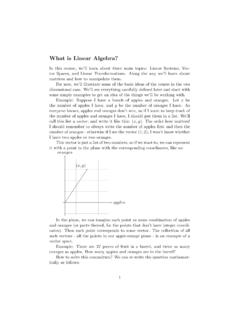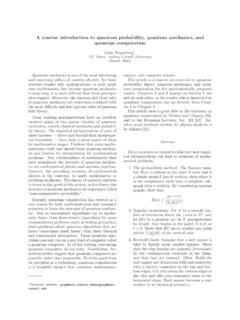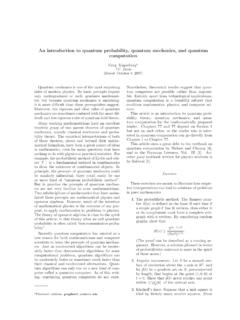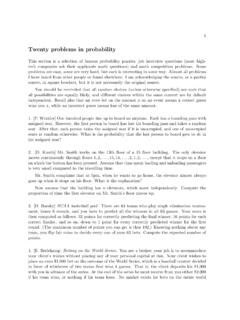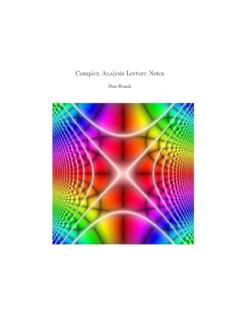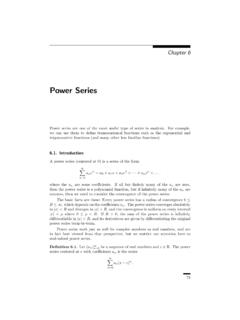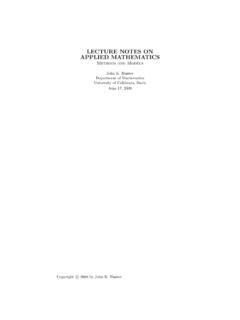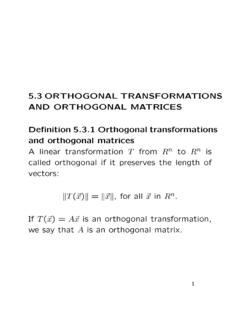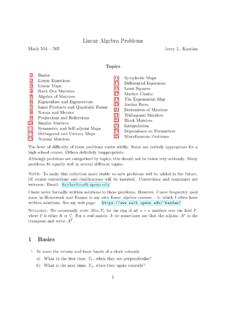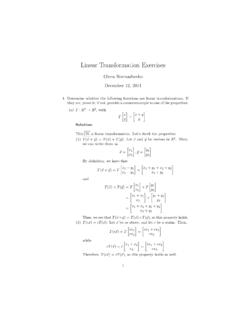Transcription of 21. Orthonormal Bases
1 21. Orthonormal Bases The canonical/standard basis . 1 0 0. 0 1 0 .. , e1 = .. , e2 = .., en = .. 0 0 1. has many useful properties. Each of the standard basis vectors has unit length: q ||ei || = ei ei = eTi ei = 1. The standard basis vectors are orthogonal (in other words, at right angles or perpendicular). ei ej = eTi ej = 0 when i 6= j This is summarized by (. 1 i=j eTi ej = ij = , 0 i 6= j where ij is the Kronecker delta. Notice that the Kronecker delta gives the entries of the identity matrix. Given column vectors v and w, we have seen that the dot product v w is the same as the matrix multiplication v T w. This is the inner product on Rn . We can also form the outer product vwT , which gives a square matrix. 1. The outer product on the standard basis vectors is interesting. Set 1 = e1 eT1.. 1. 0 .. 1 0 .. 0. = .. 0.. 1 0 .. 0. 0 0 .. 0 .. = .. 0 0 .. 0.. n = en eTn . 0. 0 .. = . 0 0 .. 1.. 1.. 0 0 .. 0. 0 0 .. 0 .. = .. 0 0 .. 1. In short, i is the diagonal square matrix with a 1 in the ith diagonal position and zeros everywhere else.)
2 1. Notice that i j = ei eTi ej eTj = ei ij eTj . Then: (. i i=j i j = . 0 i 6= j Moreover, for a diagonal matrix D with diagonal entries 1 , .. , n , we can write D = 1 1 + .. + n n . Other Bases that share these properties should behave in many of the same ways as the standard basis. As such, we will study: 1. This is reminiscent of an older notation, where vectors are written in juxtaposition. This is called a dyadic tensor,' and is still used in some applications. 2. Orthogonal Bases {v1 , .. , vn }: vi vj = 0 if i 6= j In other words, all vectors in the basis are perpendicular. Orthonormal Bases {u1 , .. , un }: ui uj = ij . In addition to being orthogonal, each vector has unit length. Suppose T = {u1 , .. , un } is an Orthonormal basis for Rn . Since T is a basis, we can write any vector v uniquely as a linear combination of the vectors in T : v = c1 u1 + .. cn un . Since T is Orthonormal , there is a very easy way to find the coefficients of this linear combination. By taking the dot product of v with any of the vectors in T , we get: v ui = c1 u1 ui +.)
3 + ci ui ui + .. + cn un ui = c1 0 + .. + ci 1 + .. + cn 0. = ci , ci = v ui v = (v u1 )u1 + .. + (v un )un X. = (v ui )ui . i This proves the theorem: Theorem. For an Orthonormal basis {u1 , .. , un }, any vector v can be ex- pressed X. v= (v ui )ui . i Relating Orthonormal Bases Suppose T = {u1 , .. , un } and R = {w1 , .. , wn } are two Orthonormal Bases for Rn . Then: 3. w1 = (w1 u1 )u1 + .. + (w1 un )un .. wn = (wn u1 )u1 + .. + (wn un )un X. wi = uj (uj wi ). j As such, the matrix for the change of basis from T to R is given by P = (Pij ) = (uj wi ). Consider the product P P T in this case. (P P T )jk =. X. (uj wi )(wi uk ). i X. = (uTj wi )(wiT uk ). i " #. X. = uTj (wi wiT ) uk i = uTj In uk ( ). = uTj uk = jk . In the equality ( ) is explained below. So assuming ( ) holds, we have shown that P P T = In , which implies that P T = P 1 . The equality in the line ( ) says that i wi wiT = In . To see this, we P. examine ( i wi wiT )v for an arbitrary vector v. We can find constants cj P.
4 Such that v = j cj wj , so that: P. X X X. ( wi wiT )v = ( wi wiT )( cj wj ). i i j X X. j = c wi wiT wj j i X X. j = c wi ij j i X. = cj wj since all terms with i 6= j vanish j = v. 4. Then as a linear transformation , P T. i wi wi = In fixes every vector, and thus must be the identity In . Definition A matrix P is orthogonal if P 1 = P T . Then to summarize, Theorem. A change of basis matrix P relating two Orthonormal Bases is an orthogonal matrix. P 1 = P T . Example Consider R3 with the Orthonormal basis 2 1 . 0 . 16 13 .. 1 .. S = u1 = 6 , u2 = 2 , u3 = 3 .. 1 1 1.. 6 2 3. Let R be the standard basis {e1 , e2 , e3 }. Since we are changing from the standard basis to a new basis, then the columns of the change of basis matrix are exactly the images of the standard basis vectors. Then the change of basis matrix from R to S is given by: . e1 u1 e1 u2 e1 u3. j P = (Pi ) = (ej ui ) = e2 u1 e2 u2 e2 u3 .. e3 u1 e3 u2 e3 u3. 2. 1.. 0. 16 3. 1 . = u1 u2 u3 = 1 . 3 .. 6 2. 1. 1 1. 6 2 3.
5 From our theorem, we observe that: . uT1. P 1 = P T. T . = u2 . uT3. 1. 2. 1.. 6 6 6 . = 0 1 1 . 2 2 . 1 1. 1. 3 3 3. 5. We can check that P T P = In by a lengthy computation, or more simply, notice that . uT1 . (P T P )ij T . = u2 u1 u2 u3. uT3.. 1 0 0. = 0 1 0 .. 0 0 1. We are using orthonormality of the ui for the matrix multiplication above. Orthonormal Change of Basis and Diagonal Matrices. Suppose D is a diagonal matrix, and we use an orthogonal matrix P to change to a new basis. Then the matrix M of D in the new basis is: M = P DP 1 = P DP T . Now we calculate the transpose of M . MT = (P DP T )T. = (P T )T DT P T. = P DP T. = M. So we see the matrix P DP T is symmetric! References Hefferon, Chapter Three, Section V: Change of Basis Wikipedia: Orthogonal Matrix Diagonalizable Matrix Similar Matrix 6. Review Questions ! 1 0. 1. Let D = . 0 2. i. Write D in terms of the vectors e1 and e2 , and their transposes. ! a b ii. Suppose P = is invertible. Show that D is similar to c d !
6 1 1 ad 2 bc ( 1 2 )bd M= . ad bc ( 1 2 )ac 1 bc + 2 ad . iii. Suppose the vectors a b and c d are orthogonal. What can you say about M in this case? 2. Suppose S = {v1 , .. , vn } is an orthogonal (not Orthonormal ) basis for Rn . Then we can write any vector v as v = i ci vi for some constants P. ci . Find a formula for the constants ci in terms of v and the vectors in S. 3. Let u, v be independent vectors in R3 , and P = span{u, v} be the plane spanned by u and v. i. Is the vector v = v u v u u u in the plane P ? ii. What is the angle between v and u? iii. Given your solution to the above, how can you find a third vector perpendicular to both u and v ? iv. Construct an Orthonormal basis for R3 from u and v. v. Test your abstract formulae starting with . u= 1 2 0 and v = 0 1 1 . 7.
